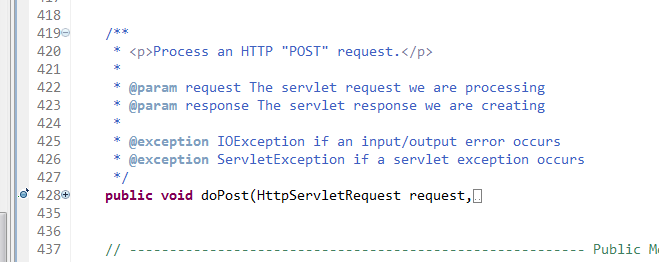Struts1之url截取
先我们来对ActionServlet深层次进行分析。我们用断点的调试的方式来看底层源码。因为这个实例是post方式提交,所以将断点设置到doPost方法上。

我们debug运行程序,进入doPost里面的方法:

这个方法非常重要是ActionServlet运行的核心方法。
我们进入这个方法:

再继续进入:

我们赫然发现了这样一个方法就是processPath方法,这个方法就是截取字符串的方法。这个方法的源代码如下:
/** * <p>Identify and return the path component(from the request URI) that * we will use to select an <code>ActionMapping</code> with which todispatch. * If no such path can be identified,create an error response and return * <code>null</code>.</p> * * @param request The servlet request weare processing * @param response The servlet response weare creating * * @exception IOException if an input/outputerror occurs */ protectedString processPath(HttpServletRequest request, HttpServletResponse response) throws IOException { String path = null; // For prefix matching, match on the path info (if any) path = (String) request.getAttribute(INCLUDE_PATH_INFO); if (path == null) { path = request.getPathInfo(); } if ((path != null) && (path.length() > 0)) { return (path); } // For extension matching, strip the module prefix and extension path = (String) request.getAttribute(INCLUDE_SERVLET_PATH); if (path == null) { path = request.getServletPath(); } String prefix = moduleConfig.getPrefix(); if (!path.startsWith(prefix)) { String msg =getInternal().getMessage("processPath"); log.error(msg + " " + request.getRequestURI()); response.sendError(HttpServletResponse.SC_BAD_REQUEST, msg); return null; } path = path.substring(prefix.length()); int slash = path.lastIndexOf("/"); int period = path.lastIndexOf("."); if ((period >= 0) && (period >slash)) { path = path.substring(0, period); } return (path); } 分析一下这段代码:
path = (String)request.getAttribute(INCLUDE_PATH_INFO); if (path == null) { path = request.getPathInfo(); } if ((path != null) && (path.length() > 0)) { return (path); } 这段代码首先判断一下javax.servlet.include.path_info是否存在路径信息,这里要知道当当一个页面是以RequestDispatcher.include方式显示的话,这个属性值才存在。所以这里没有值,就会进入path=request.getPathInfo()程序中,这里的getPathInfo获取的值是相对servlet的路径信息。
// For extension matching, stripthe module prefix and extension path = (String) request.getAttribute(INCLUDE_SERVLET_PATH); if (path == null) { path = request.getServletPath(); } String prefix = moduleConfig.getPrefix(); if (!path.startsWith(prefix)) { String msg =getInternal().getMessage("processPath"); log.error(msg + " " + request.getRequestURI()); response.sendError(HttpServletResponse.SC_BAD_REQUEST, msg); return null; } 这一段代码是判断javax.servlet.include.servlet_path是否存在值,这个也是当一个页面是以equestDispatcher.include方式显示的话,这个属性值才存在,所以这里的值没有。之后进入path = request.getServletPath();这个方法是获得返回请求URI上下文后的子串,所以这里的返回值就是“/”和访问页面名称和后缀(这里和我的mvc实例截取的是不是一样的道理)。随后进入下面代码:
path = path.substring(prefix.length()); intslash = path.lastIndexOf("/"); intperiod = path.lastIndexOf("."); if((period >= 0) && (period > slash)) { path = path.substring(0, period); } return (path); 这里的方法主要和我的上面的那里是一样的,主要就是去掉后缀。
新闻热点
疑难解答